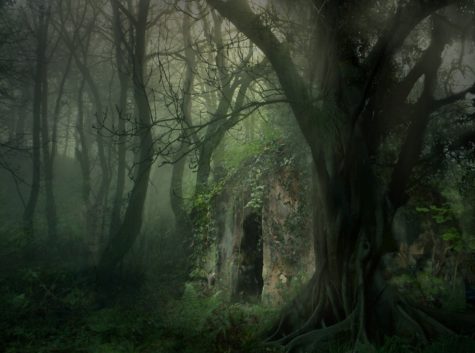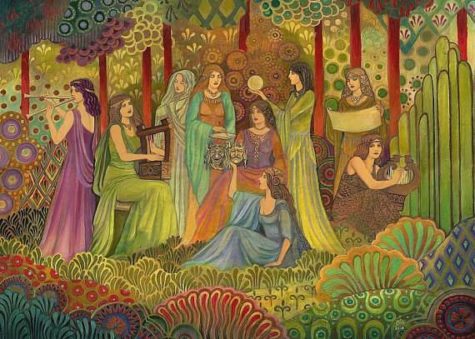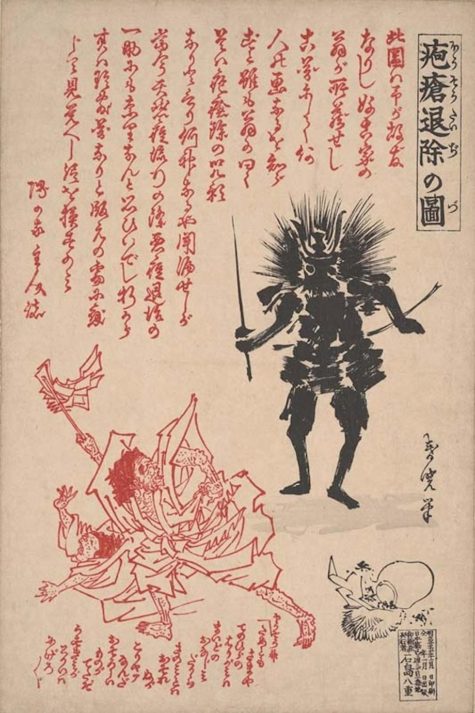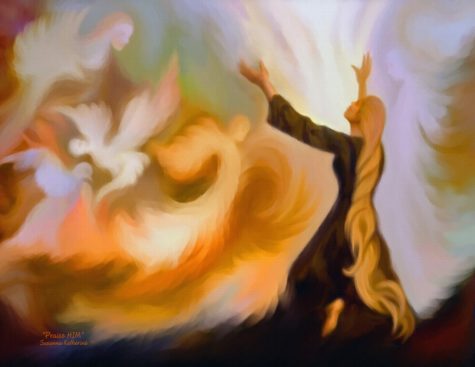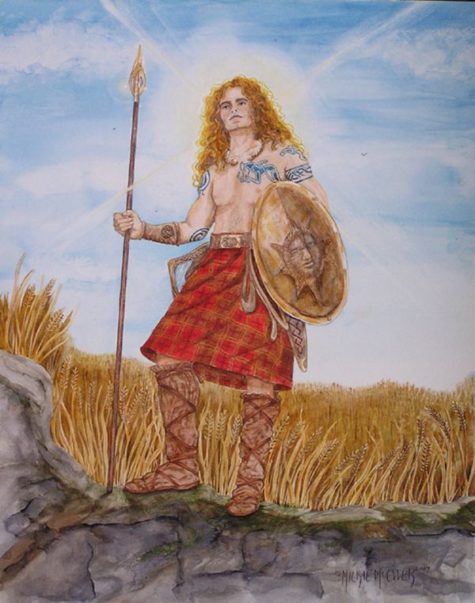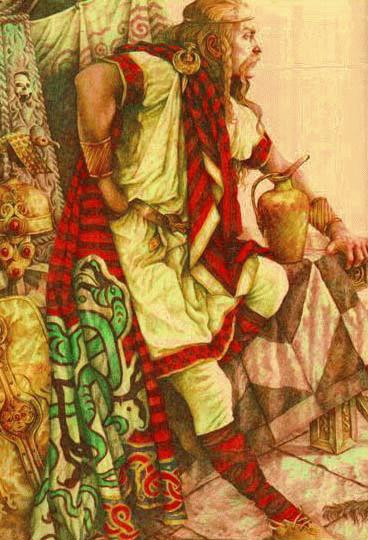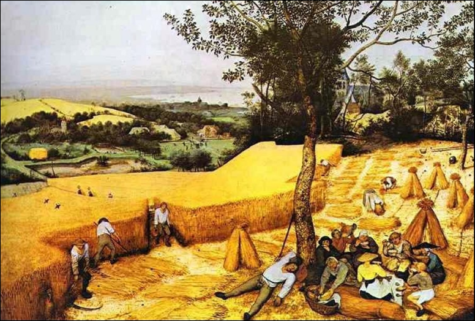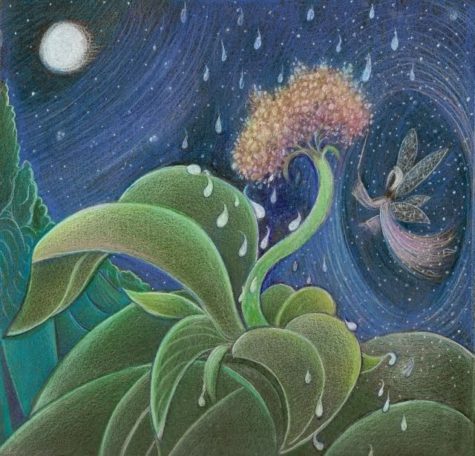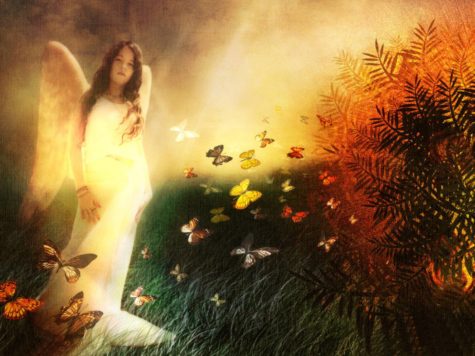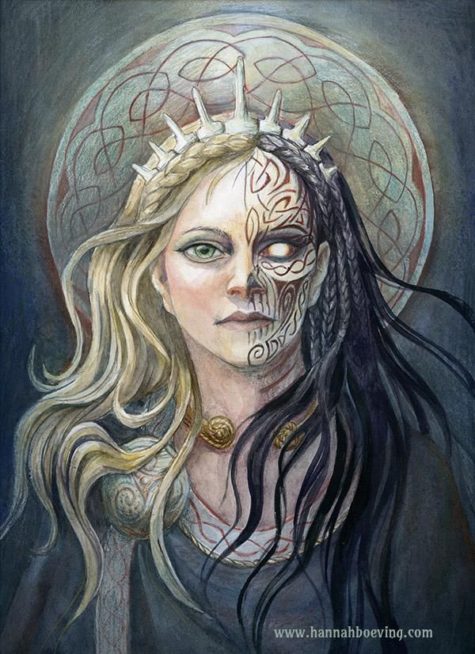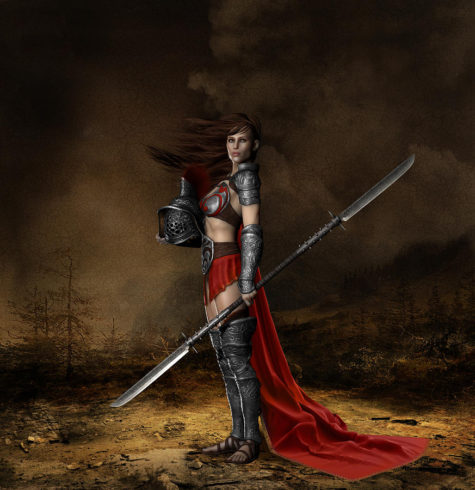The dark powers emanate from the dark aspects of the Goddess and the God. This is the power of the Crone and the Lord of the Shadows; the Hag and the Hunter. The dark powers are more than just a personification of the negative influences in life, however, and the energy raised through the dark imagery of the Divine is very potent. As such, be careful what you do.
The Dark Goddess is manifested in mythology as various kinds of death crones, wise hags, devastation, war, disease and barrenness of the land. She is the Bone Mother who collects the skulls of the dead for the ossuary. In Irish mythology, Morrigan and Nemain would be considered Dark Goddesses in that they are associated with War and Death.
The Dark God is seen in mythology as the silent host to the dead in his underground realm of gray shadows and deep sleep, knowing of secrets and wise of the universe, death, war, destruction, gatherer of souls and harbinger of chaos. He is the Hunter, whose wild hunt, or raid, ingathers the energies of the soul.
There is sense to this ancient cosmology. Cults of ancient times focused on the dark aspects of the Divine so that their followers would move past their fear of mortality to seize upon the recognition of their eternal immortality.
In Irish mythology, Crom Cruach, and Donn would be considered “Dark Gods” or “Dark Powers” because Donn was the god of the dead Milsians. At death, Mannannan Mac Lyr carried the soul to Tech Dunn or the House of Donn. In texts like the Dinsenchus there is references to Crom being considered to be a dark god, contrasting a light god, in a way that is very similar to the Slavic god Czernobog.
As a power, the Dark Lord is the Chaos from which Order must evolve. Yet there is no ending to this cycle, Order resolves again as Chaos to be reborn as New Order. The Lord of Shadows as Death becomes the process of new life by gathering the energy of dying life, and the Passage into a new material form is through the Crone.
In the aspect of light, the god dies willingly by entering the ground to bring his vitality to crops that will be harvested to feed humanity. Through this selfless act, he revitalises the earth. He does this through the Crone. The marriage of Lugh in August, celebrated as Lughnasadh, is the start of the descent into Mother Earth. Once there, he is transformed into the son within the goddess. Hence, the pagan god is both Father and Son, which is yet another concept that Christianity absorbed from the pagans. The harvest comes, the seasons change, and the Mother becomes the Crone of Autumn and Winter, only to be transformed into Mother again at Winter Solstice with the rebirth of the Sun (her son, the god). See Also: Cernunnos, Green Man and Herne.
The womb-tomb is the domain of the Crone and is a place of great power. This is where the transformation takes place, with energies of death given repose and returned to form as the energies of life. When this power is confronted and recognised, there comes a freedom from fear, a new sense of independence and a recognition of personal responsibility. We are not judged in Death by the Lady and the Lord, but we are Self-judged. From the quietude of the realm, we move through her into new life. That is the balanced, pagan theme of the cauldron, the god of self-sacrifice and the resurrecting goddess. It is this power of the goddess that significantly differentiates the old and new religions.
Thus, in an historical sense, while the Dark Lord guides the chaos of social and cultural changes through the Crone into a new life, the Crone becomes not the terror of death, but the joyful passage to new vibrant societies through the death of the outmoded and stagnant ones. She is Fata Morgana, the Huntress Diana, Minerva, Cerridwen, Sati and Kali. He is Pluto, Hades, Cerunnos, Herne the Hunter, Set and Shiva. But the names may not convey the image needed by the practitioner unless you are able to move beyond the modern association of darkness as evil.
By accepting that the dark powers are in balance with the light powers, you are able to utilise the wholeness of the Power. The dichotomy of good and evil do not apply to what simply is. Energy can be drawn to the light or to the dark; thus death provides the soul’s passage to whichever realm the soul-energy has been drawn. Energy is always in motion, and flows back and forth between light and dark. What at one time is light energy turns and becomes dark energy. Through the practice of the Craft, the witch directs this energy for beneficial purpose. To do otherwise, is to inflict Self-harm.
To face the Underworld and the power of the dark aspect of the Divine is to understand that dark is part of the necessary blend of light and not something to fear. The unifying of the dark and the light within the individual offers wholeness and peace, which may then be transferred to external contacts.
From: Green Witchcraft II
The Horae (Greek Goddesses of the hours) personified the twelve hours (originally only ten), as tutelary goddesses of the times of day. The hours run from just before sunrise to just after sunset, thus winter hours are short, summer hours are long. Here’s the list:
- Auge, first light
- Anatolê or Anatolia, sunrise
- Mousikê or Musica, the morning hour of music and study
- Gymnastikê, Gymnastica or Gymnasia, the morning hour of gymnastics/exercise
- Nymphê or Nympha, the morning hour of ablutions (bathing, washing)
- Mesembria, noon
- Sponde, libations poured after lunch
- Elete, prayer, the first of the afternoon work hours
- Aktê, Acte or Cypris, eating and pleasure, the second of the afternoon work hours
- Hesperis, evening
- Dysis, sunset
- Arktos or Arctus, night sky, constellation
An interesting practice to bring a deeper understanding of the Goddess energy, and a deeper connection to the rhythms of the day is to take a short moment to acknowledge each goddess at her approximate time. This can be as simple as a small salute or short hello. You might be pleasantly surprised at the magickal turn your life takes when you practice this consistently over time.
The Horae are the joyous goddesses of the seasons. Daughters of Zeus and Themis, they are spirits of abundance. The Horae organized the seasons and devised the earliest calendar, establishing the length of months, weeks, days, minutes, and hours. They are the goddesses of the correct movement, spirits of perfect timing.
They are the truthful ones who guard the gates of Olymus. Although described as the daughters of Zeus, legends suggest that they were the ones who raised Hera. (It’s been theorized that they were originally only Themis’ possibly parthogenic daughters. Later, when paternity became significant, Zeus was incorporated into the myth.)
In their earliest manifestations, there were only two or three Horae. Eventually, however, more joined them until there were twelve Horae. They are closely allied with Hera, Aphrodite, and Dionysus:
- The Horae open the gates of the sky for Hera.
- Hera can allegedly be contacted via the Horae. Contact them first and request that they intercede.
- The Horae are among those who greeted and clothed Aphrodite when she rose from the sea.
- They dance in the entourage of Dionysus.
- The Horae are Dionysus’ partners in viniculture, responsible for the ripening of grapes.
The blessings of the Horae are invoked on brides, weddings, and children.
The ancient Greeks did not have hours of fixed length as we do today. Instead they divided the hours of daylight into twelve portions identified by the position of the sun in the sky. Thus the length of the hour varied between the longer days of summer and shorter ones of winter.
The twelve Horai were not always clearly distinguishable from the Horai of the seasons who were also described as overseeing the path of the sun. From the Nonnus, Dionysiaca, a Greek Epic from the 5th century AD:
“The four Horai (Seasons) were greeted by the twelve circling Horai (Hours), daughters of Khronos (Chronos, Time), tripling round the fiery throne of the untiring Charioteer in a ring, servants of Helios that attend on his shining car, priestesses of the lichtgang each in her turn : for they bend the servile neck to the ancient manager of the universe.”
Sources:
- Origin: Japan
- Classification: Kami
- Color: Red
- Offerings: Rice with red adzuki beans
Hosogami are smallpox spirits. (Hoso is the Japanese word for smallpox.) For safe recovery to health, the Hosogami must be soothed, propitiated, and sent on their way. Hosogami are pleased to see the color red. Physicians were glad to see the color red too:
- Purple smallpox rashes indicate the illness is in a dangerous stage.
- If and when rashes turn red, the patient is expected to recover.
The person suffering from small pox and those caring for him dressed in red to appease the Hosogami. In addition, “red prints” or hoso-e prints, paper wall amulets were posted at the first hint of small pox to propitiate, avoid, and/or banish the illness.
Daruma and Shoki possess the power to expel Hosogami and are among the spirits portrayed on red smallpox talismans.They are called “red” because that’s the primary color of these prints. If no print is available, red banners may suffice.
Following the patient’s recovery, these prints were traditionally ritually burned or floated down rivers to signal the departure of the spirit. Extremely few survive and these are now extremely valuable collectors items.
Source: Encyclopedia of Spirits
In praying to most gods, the Greeks stood holding the arms upward. When praying to a sea god, the arms were held forward; to an Earth or underworld deity, the arms were held down toward the ground, at the same time stamping on the Earth to attract the deity’s attention.
In all ritual positions, they faced East. When praying in temples, they faced the altar and the deity’s statue.
From: Moon Magick
Lugh (pronounced LOO) was known to the Celts as a god of craftsmanship and skill — in fact, he was known as the Many-Skilled God, because he was good at so many different things. In one legend, Lugh arrives at Tara, and is denied entrance. He enumerates all the great things he can do, and each time the guard says, “Sorry, we’ve already got someone here who can do that.” Finally Lugh asks, “Ah, but do you have anyone here who can do them ALL?”
- Origin: Celtic
- Attributes: Magical spear, harp
- Bird: Raven
- Animal: Lion, horse
- Planet: Sun
- Plant: Red corn cockles
Lugh, Lord of Craftsmanship, Light, Victory and War, is a master builder, harpist, poet, warrior, sorcerer, metalworker, cupbearer and physician. It’s hard to envision anything at which Lugh does not excel.
- Also known as:
Lug, Luc, Lugos, Lleu Llaw Gyffes, Bright One of the Skillful Hand - Favored people:
Artisans, crafts people, poets, artists, physicians, soldiers, and warriors. - Manifestation:
Shining, handsome, charming and witty. He has a silver tongue to match his skillful hands. - Consorts:
Lugh has different consorts in different locations but he was frequently linked to Rosemerta. - Spirit Allies:
Lugh shared the city of Lyon with Kybele and Paris with Isis. In battle, Lugh used his own weapons but also those belonging to Manannan.
Lugh was venerated throughout the ancient Celtic world. Modern scholars perceive him as especially significant because his veneration indicates the existence of pan-Celtic spiritual traditions. (Celts once ruled a huge swathe of continental Europe before being forced to the very edges of the continent.)
At least fourteen European cities are named for Lugh including Laon, Leyden, Loudon and Lyon. Lyon’s old name was Lugduhum, meaning “Lugh’s Fort.” Tat city is believed to have been his cult center. Its coins bore the images of ravens which may be a reference to Lugh. Carlisle in England, the former Lugubalium, is also named in Lugh’s honor. Some theorize that Lugh’s name is reflected in an older name for paris: Lutetia.
The Romans identified Lugh with Mercury. Many European churches dedicated to Michael the Archangel are believed to have been built over sites once dedicated to Lugh. Post-Christianity many of Lugh’s sacred functions were reassigned to saints like Patrick and Luke.
Lugh apparently traveled westward through Europe. Irish and Welsh myths describe his first appearance in their pantheon. He is greeted with resistance from women in Wales. His first public act in Ireland is to join battle with the Tuatha De Danaan (his father’s people) against the Fomorian, his mother’s people. Lugh chooses allegiance with the paternal line; the myth may be interpreted as indicating the beginnings of patriarchy in Ireland.
- Feast: August 1st
August 1st is the festival of Lughnasadh. Lughnasadh (sometimes spelled Lughnasa) means “the marriage of Lugh.” Lugh the sun and the Earth Mother renew their wedding vows annually during the full moon in August and invite all to gather and revel with them. Lughnasadh celebrates the consummation of their sacred relationship.
Once upon a time, Lughnasadh was a four week festival.: the last two weeks of July and the first two weeks of August, roughly corresponding to when the sun is in Leo, the astrological sign that belongs to the sun and epitomizes its power. In modern Irish Gaelic, the month of August is Lunasa. However the modern Wiccan sabbat of Lughnasadh is almost always devoted solely to the eve of July 31 leading into Lughnasadh Day on August 1st.
Celebrating Lugh Today:
Lughnasadh is a pagan holiday is dedicated to this capable God, and is celebrated every year on August 1st.
Take the opportunity this day to celebrate your own skills and abilities, and make an offering to Lugh to honor him, the god of craftsmanship.
Here’s How:
Before you begin, take a personal inventory. What are your strong points? Everyone has a talent — some have many, some have one that they’re really good at. Are you a poet or writer? Do you sing? How about needlecraft, woodworking, or beading? Can you tap dance? Do you cook? How about painting? Think about all the things you can do — and all of the things you’d like to learn to do, and the things you’d like to get better at. Once you sit down and think about it, you might be surprised to realize how accomplished you really are.
Decorate your altar with items related to your skill or talent. If your skill relates to something tangible, like sewing or jewelry-making, put some of your craft supplies on the altar. If it’s an ability to DO, rather than MAKE, such as dancing or singing, put some symbol of your ability on your altar. Do you have a favorite outfit you wear when you dance? A particular song lyric that you know you’re fabulous with? Add as many items as you like to your altar.
You’ll need a candle to symbolize Lugh, the god. Any harvest color is good, because he came up with the idea of a grain festival to honor his foster mother, Tailtiu. Place the candle on your altar in the center. Feel free to add some stalks of grain if you like — you can combine this rite with one honoring the harvest, if you choose.
Light the candle, and take a moment to think about all the things you are good at. What are they? Are you proud of your accomplishments? Now’s your chance to boast a little, and take some pride in what you’ve learned to do.
Announce your own talents in the following incantation. Say:
Mighty Lugh, the many-skilled god,
he who is a patron of the arts,
a master of trades, and a silver-tongued bard.
Today I honor you, for I am skilled as well.
I am deft with a needle,
strong of voice,
and paint beauty with my brush strokes.*
*Obviously, you would insert your pride in your own skills here.
Now, consider what you wish to improve upon. Is your tennis-playing out of whack? Do you feel inadequate at bungee jumping, yodeling, or drawing?
Now’s the time to ask Lugh for his blessing. Say:
Lugh, many-skilled one,
I ask you to shine upon me.
Share your gifts with me,
and make me strong in skill.
At this time, you should make an offering of some sort. The ancients made offerings in exchange for the blessings of their gods — quite simply, petitioning a god was a reciprocal act, a system of exchange. Your offering can a tangible one: grain, fruit, wine, or even a sample of your own talents and skills — imagine dedicating a song or painting to Lugh. It can also be an offering of time or loyalty. Whatever it is, it should come from the heart.
Say:
I thank you, mighty Lugh, for hearing my words tonight.
I thank you for blessing me with the skills I have.
I make this offering of (whatever it is you are offering) to you
as a small token of honor.
Take a few more moments and reflect on your own abilities. Do you have faith in your skills, or do you deflect compliments from others? Are you insecure about your abilities, or do you feel a surge of pride when you sew/dance/sing/hula hoop? Meditate on your offering to Lugh for a few moments, and when you are ready, end the ritual.
Tips:
If you are performing this rite as part of a group, family or coven setting, go around in a circle and have each person take their turn to express their pride in their work, and to make their offerings to Lugh.
Sources: Encyclopedia of Spirits and PaganWiccan
When Lammastide rolls around, the fields are full and fertile. Crops are abundant, and the late summer harvest is ripe for the picking. This is the time when the first grains are threshed, apples are plump in the trees, and gardens are overflowing with summer bounty. In nearly every ancient culture, this was a time of celebration of the agricultural significance of the season. Because of this, it was also a time when many gods and goddesses were honored. These are some of the many deities who are connected with this earliest harvest holiday.
Adonis (Assyrian): Adonis is a complicated god who touched many cultures. Although he’s often portrayed as Greek, his origins are in early Assyrian religion. Adonis was a god of the dying summer vegetation. In many stories, he dies and is later reborn, much like Attis and Tammuz.
Attis (Phrygean): This lover of Cybele went mad and castrated himself, but still managed to get turned into a pine tree at the moment of his death. In some stories, Attis was in love with a Naiad, and jealous Cybele killed a tree (and subsequently the Naiad who dwelled within it), causing Attis to castrate himself in despair. Regardless, his stories often deal with the theme of rebirth and regeneration.
Ceres (Roman): Ever wonder why crunched-up grain is called cereal? It’s named for Ceres, the Roman goddess of the harvest and grain. Not only that, she was the one who taught lowly mankind how to preserve and prepare corn and grain once it was ready for threshing. In many areas, she was a mother-type goddess who was responsible for agricultural fertility.
Dagon (Semitic): Worshiped by an early Semitic tribe called the Amorites, Dagon was a god of fertility and agriculture. He’s also mentioned as a father-deity type in early Sumerian texts and sometimes appears as a fish god. Dagon is credited with giving the Amorites the knowledge to build the plough.
Demeter (Greek): The Greek equivalent of Ceres, Demeter is often linked to the changing of the seasons. She is often connected to the image of the Dark Mother in late fall and early winter. When her daughter Persephone was abducted by Hades, Demeter’s grief caused the earth to die for six months, until Persephone’s return.
Lugh (Celtic): Lugh was known as a god of both skill and the distribution of talent. He is sometimes associated with midsummer because of his role as a harvest god, and during the summer solstice the crops are flourishing, waiting to be plucked from the ground at Lughnasadh.
Mercury (Roman): Fleet of foot, Mercury was a messenger of the gods. In particular, he was a god of commerce and is associated with the grain trade. In late summer and early fall, he ran from place to place to let everyone know it was time to bring in the harvest. In Gaul, he was considered a god not only of agricultural abundance but also of commercial success.
Neper (Egyptian): This androgynous grain deity became popular in Egypt during times of starvation. He later was seen as an aspect of Osiris, and part of the cycle of life, death and rebirth.
Parvati (Hindu): Parvati was a consort of the god Shiva, and although she does not appear in Vedic literature, she is celebrated today as a goddess of the harvest and protector of women in the annual Gauri Festival.
Pomona (Roman): This apple goddess is the keeper of orchards and fruit trees. Unlike many other agricultural deities, Pomona is not associated with the harvest itself, but with the flourishing of fruit trees. She is usually portrayed bearing a cornucopia or a tray of blossoming fruit.
Tammuz (Sumerian): This Sumerian god of vegetation and crops is often associated with the cycle of life, death, and rebirth.
Elemental fairies (being one type of fairy) “are the thought-forms of the Great Beings, our angels, who are in charge of the evolution of the vegetable kingdom. When one of these Great Ones has a new idea connected with one of the kinds of plants or flowers which are under his charge, he often creates a thought-form for the special purpose of carrying out that idea.
It usually takes the form either of an etheric model of the flower itself or of a little creature which hangs round the plant or the flower all through the time that the buds are forming, and gradually builds them into the shape and color of which the angel has thought. But as soon as the plant has fully grown, or the flower has opened, its work is over and its power is exhausted, and, as I have said, it just simply dissolves, because the will to do that piece of work was the only soul that it had.
~C. W. Leadbeater:
Doreen Virtue in her book Earth Angels tells how some of us are Incarnated Elementals (Nature Spirits) and animals. There are five categories of Earth Angels: Wise Ones, Incarnated Angels, Starpeople, Walk-Ins, and Incarnated Elementals. According to Doreen, the following are characteristics of each category:
Incarnated Angels tend to – have sweet, heart shaped faces; have overeating and weight issues; be a fixed astrological sign (Leo, Taurus, Sagittarius, Scorpio and Aquarius); be professional helpers (teachers, healers, customer service); lighten or highlight their hair; have difficulty saying no; love angel objects; have extra guardian angels; seem to glow; fall in love with someone’s potential and tend to coax their greatness; have co-dependent relationships with addicts; have voluptuous bodies; have mellow personalities; stay in relationships much longer than they should; and obey rules.
Incarnated Elementals/Nature Spirits tend to – disobey rules; have mischief in their eyes; have slim bodies or fast metabolisms; have sensitive nervous systems; be addicts; love to party; prefer the company of animals over people; be warriors for the Earth; love nature; have comedic, musical or artistic skills; be noncommittal or immature; have Celtic origins; play practical jokes; fiercely independent; have finances that are feast or famine; and have powerful energy to manifest things they desire.
Star People tend to – be socially awkward; believe in UFO’s or ET’s; be compulsively thoughtful without need for appreciation; conduct Reiki or other energy healing; follow their life’s mission which may be more important than getting married or having kids; and don’t feel Earth is their home.
Walk-In’s tend to – have had a life changing accident or experience; have attempted suicide; have changed names; are “different” than they used to be; have made drastic changes to their life; and have a deep spiritual knowledge. (through a life changing event or near death experience, these souls have entered into a body mid-life.)
Wise Ones tend to – get along well with most people; have magical abilities; have past life memories of Arthurian or Atlantean times; believe that they were persecuted for their beliefs in a past life; study tarot or astrology; and be drawn to earth-based spirituality like shamanism or full-moon ceremonies.
- Also known as: Hella, Hela
- Origin: Norse
- Colors: Black and white
- Rune: Hagalaz
- Mount: Hel rides a black mare
- Animals: She has a pack of dogs, the original Hell Hounds, as well as horses and wolves
- Spirit allies: Hel’s staff includes servants named “Delay” (male) and “Slowness” (female)
Manifestations:
Hel is simultaneously half-dead and half-alive. Half of her body (cut vertically) is that of a fair, beautiful woman; the other half is necrotized flesh. She is half living woman, half corpse.
Attributes:
Rake and broom; the Black Plague was especially devastating in Scandinavia. Allegedly Hel roamed the land armed with her rake and broom. Villages totally wiped out by the Plague were said to have been swept away; where there were survivors, Hel had raked instead.
The Mythology:
Once upon a time, being sent to Hel may have been inevitable, but it wasn’t perceived as punishment: Hel, daughter of Angerboda and Loki, rules the Norse realm of the dead. She is the keeper of the souls of the departed. Those who die at sea or in battle have other destinations; everyone else goes to Hel, who welcomes them into her home, Helhaim, regardless of whether they were good, bad, sinful, or saintly while alive.
Hel’s realm is not a sulphurous, fiery torture chamber. Rather it is a kind of inn or way station for the dead, although once checked in, one can never check out. Helhaim is a bleak gray, damp, misty realm; the concept of heat as punishment was imported from hotter, southern climes alongside Christianity. Lack of warmth with no hope of Spring was the Norse equivalent of desolation. That said, some regions of Helhaim are more comfortable than others; Hel judges and decides exactly where each individual soul is directed.
Hel’s name may derive from the Old German halja, meaning “covering.” She may or may not be the same spirit as Hulda (Holle). Hel and her brothers, a wolf and a snake, were raised by their mother, the witch Angerboda, in the Iron Wood. Prophecy suggested that the siblings would someday lead a Host of Destruction against the Aesir, and so Odin had them “brought” to Asgard, where each was ultimately entrapped. Odin personally seized Hel and flung her as far as he could; she landed in the Realm of Death and became its Queen. She lives in a great hall, Eliundnir, within Helhaim. She remains destined to lead an uprising of rebellious spirits and ghosts.
Hel manifests in dreams, most famously to Balder, Odin’s son. She appeared to him three days before his death, advising him (accurately) that in three days she would clasp him in her arms. Because her father was instrumental in killing Balder, it’s unclear how much inside information Hel possessed.
Places:
Mount Hekla, an active volcano in southern Iceland, was allegedly among the entrances to Hel’s realm. A nearby town is named Hella. Some have suggested that the mountain shares its name with the goddess, although others protest that Hekla means “slab” or covering,” which would still make it cognate with Hel as that is what her name means, too. It’s also theorized that the Belgian city of Hal may be named in her honor.
Feast Days:
The Anglo-Saxon and Norse Goddess of the Underworld is honored annually on the Day of Hel (July 10th) with prayers, the lighting of black candles, and offerings of rose petals.
Found in: Encyclopedia of Spirits
- Also known as: Bella Donna; Duellona
- Origin: Rome; possibly Etruscan
- Feast Day: June 3
Bellona, Goddess of War and Conquest, was once extremely popular with Roman soldiers. Roman senate meetings pertaining to foreign wars were conducted in Bellona’s temple on the Capitoline Hill.
Bellona’s name derives from the same root as bellicose and belligerent. Some consider it safer to call her Bella Donna. Bella Donna, literally “Beautiful Lady,” contains the name Bellona within it. It may be a euphemistic pun so that one could refer to Bellona without actually calling upon this beautiful but fierce lady.
Classical Roman mythology classifies Bellona, Lady of War, as belonging to the family of Mars. She is variously described as the wife or sister of Mars, less often his daughter, and sometimes his charioteer or nurse.
- Favored people: Soldiers, those who battle.
- Manifestation: A beautiful woman with long windswept hair, girded for battle.
- Attributes: Scourge; whip (to whip troops into frenzy); torch (to light her opponents’ funeral pyres).
- Sacred plant: Belladonna, (atropa belladonna), a beautiful but lethal killer, shares her essence.
- Sacred Sites: In addition to her Roman temple, Bellona had a temple outside York, England, and a shrine in Arfeuilles, France, now home of the Black Madonna of the Hollies. She was venerated wherever Roman soldiers traveled.
This goddess did not play a significant role in either myth or legend, and her worship appears to have been promoted in Rome chiefly by the family of the Claudii, whose Sabine origin, together with their use of the name of Nero, has suggested an identification of Bellona with the Sabine war goddess Nerio.
Her temple at Rome, dedicated by Appius Claudius Caecus (296 B.C.) in fulfillment of a a vow during the Third Samnite War with the Samnites and Etruscans, stood in the Campus Martius, near the Flaminian Circus and Porta Carmentalis (the Carmenta gate), and outside the gates of the city. It was there that the senate met to discuss a general’s claim to a triumph, and to receive ambassadors from foreign states. In front of it was the columna bellica, where the fetialis ceremony of declaring war was performed, in which a spear was cast against the distant enemy.
Note:
This native Italian goddess should not be mistaken for the Asiatic Bellona, whose worship was introduced into Rome apparently by Sulla, to whom she had appeared, urging him to march to Rome and bathe in the blood of his enemies. Her feast day was changed to the 24th of March, after the confusion of the Roman Bellona with her Asiatic namesake. See Day of Blood
